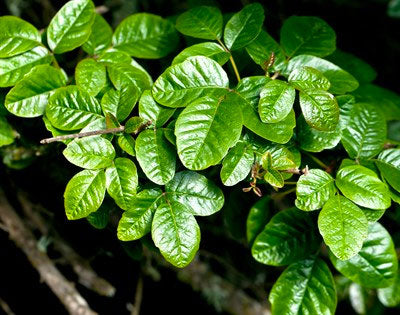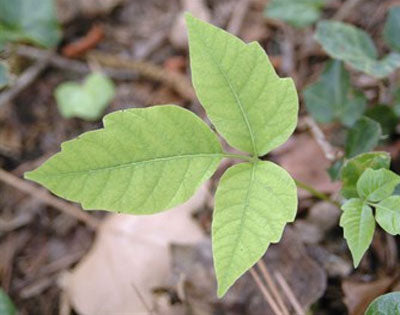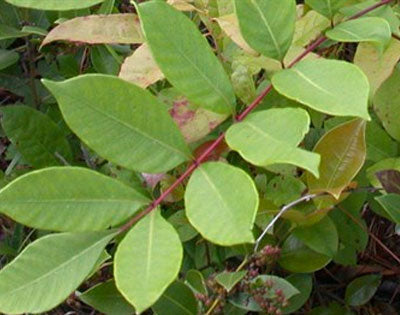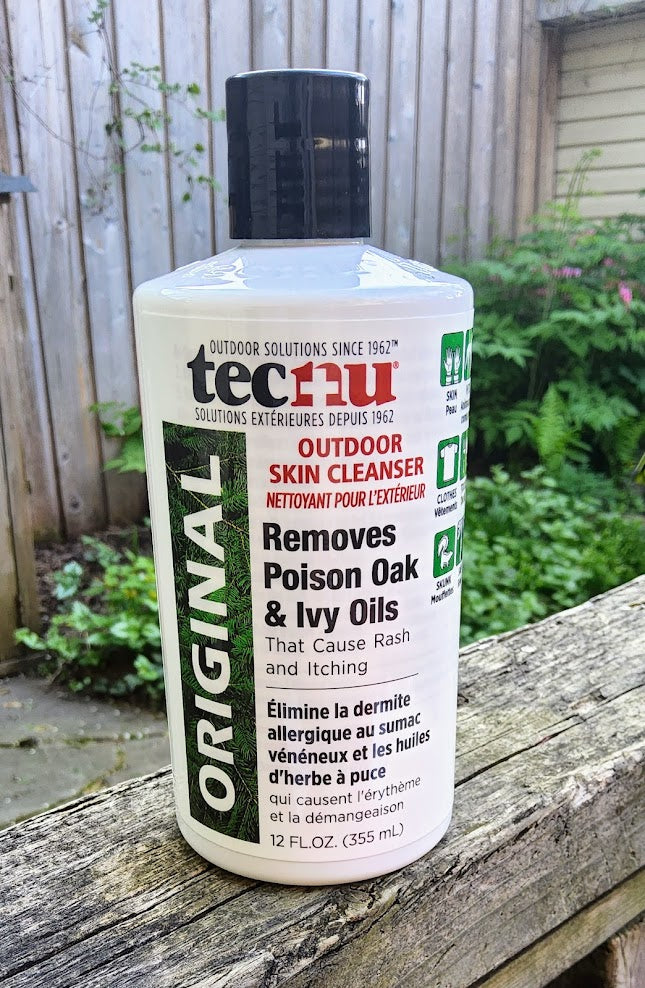Western Poison Oak

Identification
The plant can grow as a dense shrub in open sunlight or a climbing vine in shaded areas. The
three leaflets have scalloped edges resembling the leaves of a true oak and can be bronze,
bright green, yellow-green or reddish depending on the season. Poison oak can produce
greenish-white or tan berries.
General Poisoning Notes
Western poison-oak (Rhus diversiloba; synonym Toxicodendron diversiloba) is a native shrub
found in southwestern British Columbia. This plant contains urushiol, which is highly
sensitizing in humans. Reactions can range from mild redness to large areas of oozing lesions
and fever.
Geographic Information
British Columbia
Poisonous Plant Parts
All parts of the plant, with the exception of the pollen, anthers, xylem, and epidermis,
contain the allergen urushiol. Even in winter, sap from damaged stems causes allergic reactions.
Similarly, damage to the root results in dermatitis.
Poison Ivy

Identification
(Rhus radicans; synonym Toxicodendron radicans) is a native shrub or vine found throughout
southern Canada. Poison Ivy Grows throughout much of North America including all Canadian
provinces except Newfoundland (and the Territories) and all U.S. states except Alaska, Oregon,
Hawaii and California. The plants can grow as a shrub, up to about 4 feet tall, as a
groundcover, or as a climbing vine. The color of poison ivy's three almond-shaped leaflets
range from light to dark green and turn bright red in the fall. Poison ivy berries are a
grayish-white color.
General Poisoning Notes
Three recognized varieties are found in various parts of the country (Mulligan and Junkins
1977). Urushiol is the allergenic agent found in most parts of the plant. Damage to plant
tissues causes the nonvolatile chemicals to be exposed. Humans are often sensitized, with
symptoms ranging from mild itchiness and redness to severe oozing lesions with fever. Poison
ivy is probably responsible for more cases of plant dermatitis in Canada than any other plant.
Urushiol can contaminate clothes, tools, and the fur of domestic animals. Humans can
subsequently develop dermatitis from contact. Humans do not contract the dermatitis on first
contact, but most people are sensitized the first time.
Geographic Information
Alberta, British Columbia, Manitoba, New Brunswick, Nova Scotia, Ontario, Prince Edward Island.
Quebec, Saskatchewan.
Toxic Parts
All parts, leaves, plant juices.
Poison Sumac

Identification
Found in eastern United States as far west as Idaho and in Canada it is a native shrub or
vine found in southern Quebec and southern Ontario, poison sumac grows exclusively in very
wet or flooded soils, usually in swamps or peat bogs. Poison sumac has compound leaves with
7-13 leaflets, and the veins from the leaflets are always red. The plant grows as a shrub
and produces fruit that is a small white or gray berry.
General Poisoning Notes
Poison sumac (Rhus vernix; synonymy Toxicodendron vernix) is. The sap of this plant contains
the allergen urushiol. The chemical is released when plant tissue is damaged. Humans are
highly sensitive to allergic reaction, although at least one exposure is needed for
sensitization. Mild to severe dermatitis can result from exposure to poison sumac.
Geographic Information
Ontario, Quebec
Poisonous Plant Parts
Most parts of poison sumac contain the allergen except the pollen, anthers, xylem, and
epidermis. Damage to plant parts releases the sap that contains the allergen. The allergen
occurs in the plant sap, which is found in all plant parts except the pollen, anthers,
xylem, and epidermis. If the stems are damaged they can release the allergen, even in the
winter. The roots are also dangerous.




